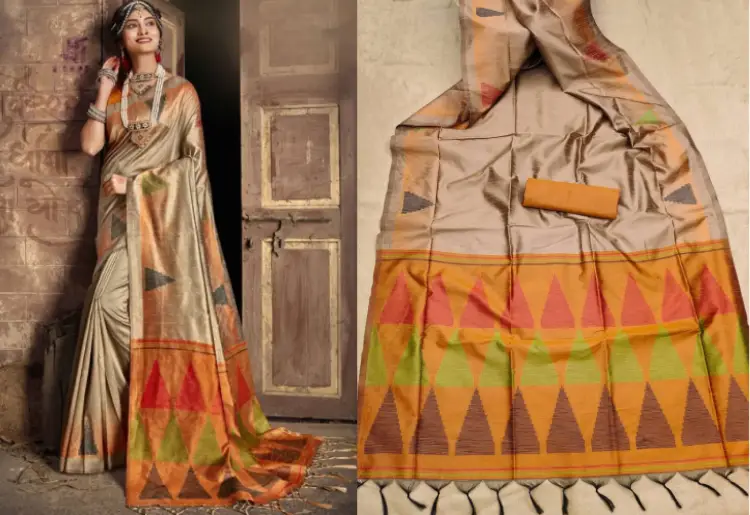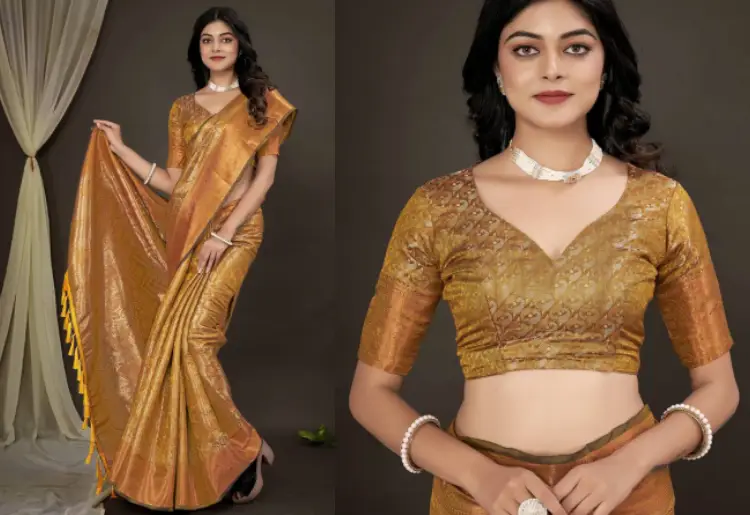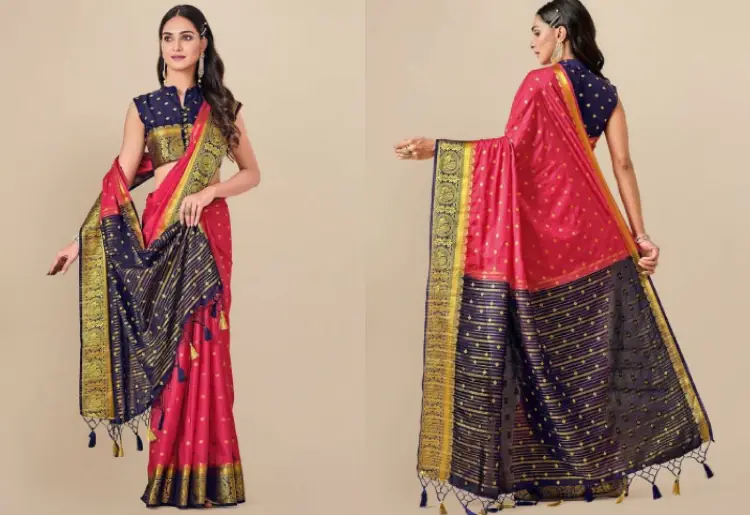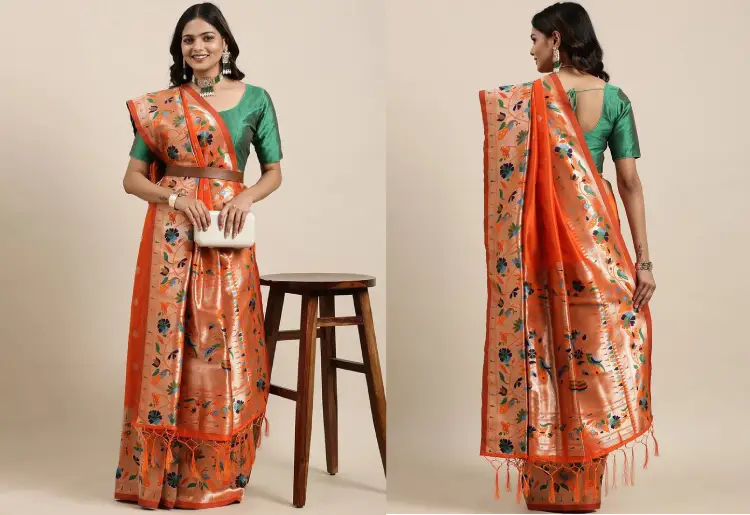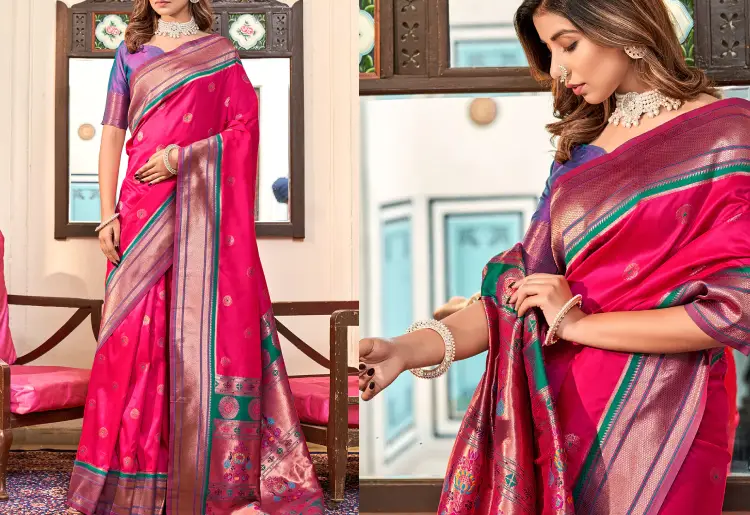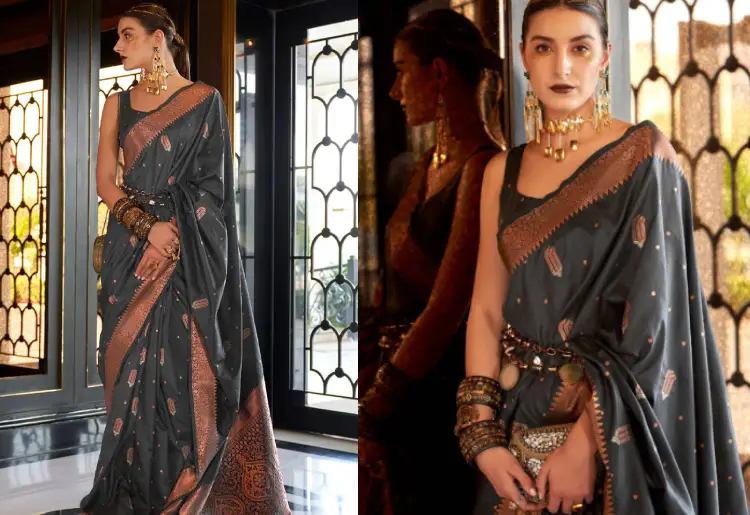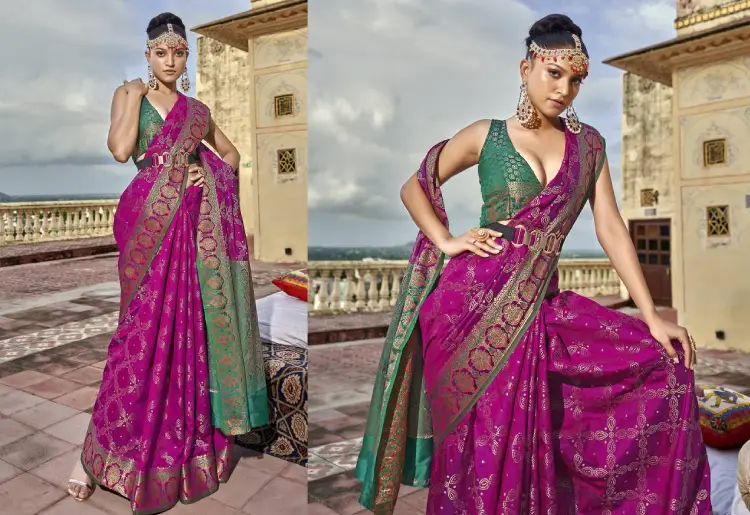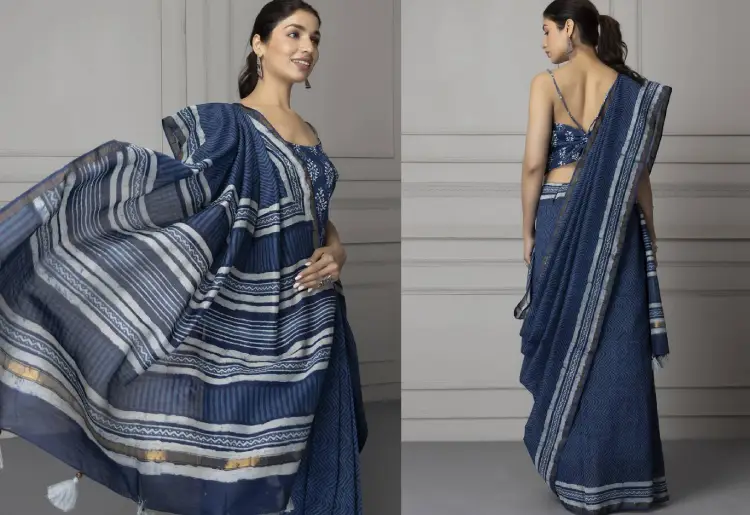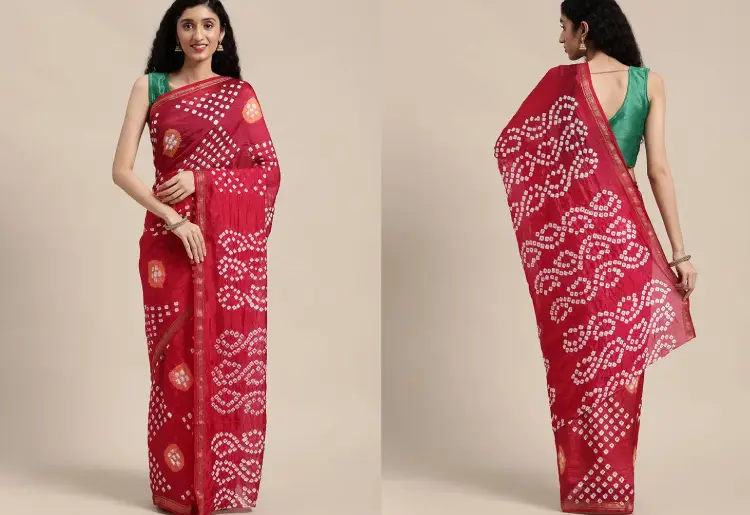A saree is a traditional piece of clothing in the Indian culture. Be it a grandma or a young girl, a saree can be found in both their wardrobes. Indian women select saree over any other apparel for their marriage, graduation party, or freshers party. A silk saree is perhaps the one which is in demand the most simply because of the style, comfort, and vibrancy it brings with itself.
Indian actress Rekha popularized the kanjeevaram silk saree. Vidya Balan followed her footsteps and took the kanjeevaram silk saree to a whole new level. Similarly, the paithani silk sari was popularized by B-town diva Shraddha Kapoor.
Here is a list of 11 types of gorgeous silk sarees every woman must have in her wardrobe:
Raw Silk Saree
This type of silk saree is made from the freshest form of silk. Unlike other silk sarees, the raw silk saree is fairly plain and bland which in fact is its unique selling proposition. You can expect the saree cloth to be a bit sturdy and hard because the silk it is made from is raw. Also, the surface of this saree doesn’t have a whole lot of work. The base color is generally light with a contrasting border.
Kanjeevaram Silk Saree
- Kanjeevaram Silk Sarees, also known as Kanchipuram sarees, are renowned for their exquisite craftsmanship and rich weaving traditions. When choosing Kanjeevaram silk sarees, there are some key factors to consider:
- Authenticity: Look for the Government of India’s Silk Mark certification to ensure that the saree is genuine Kanjeevaram silk.
- Design and Patterns: Kanjeevaram sarees are famous for their striking designs and vibrant colors, often featuring intricate motifs like peacocks, temple borders, and floral patterns.
- Silk Quality: It is important to check the silk quality as pure Kanjeevaram sarees are made from high-quality silk threads, resulting in a lustrous fabric with a soft texture.
- Zari Work: Pay attention to the zari work, which involves the use of gold or silver metallic threads to create beautiful designs and borders on Kanjeevaram silk sarees.
- Price Range: Kanjeevaram sarees range in price depending on factors such as the intricacy of design, zari work, and silk quality.
Mysore Silk Saree
Mysore Silk Sarees are known for their exquisite craftsmanship and rich heritage. Here are some key features that make them unique:
- Origin: Mysore Silk Sarees originated in Karnataka, India.
- Material: They are made from pure silk, giving them a luxurious feel and a lustrous appearance.
- Weaving Technique: Mysore Silk Sarees are woven using traditional methods, such as the ‘Kasuti’ embroidery, which adds intricate designs.
- Designs and Patterns: They often feature elegant and intricate motifs, including traditional, floral, and geometric patterns.
- Genuine Quality: Authentic Mysore Silk Sarees bear the Government Silk Mark, ensuring their genuineness and quality.
Pro-tip: When purchasing Mysore Silk Sarees, look for reputable sellers who source directly from Mysore to ensure you are getting an authentic product.
Banarasi Silk Saree
- Banarasi Silk Sarees are a popular choice among women due to their rich heritage and intricate craftsmanship.
- Origin: Banarasi Silk Sarees are traditionally handwoven in Varanasi (formerly known as Banaras), India.
- Material: These sarees are made from high-quality silk, known for its lustrous appearance and smooth texture.
- Designs: Banarasi Silk Sarees are characterized by their elaborate designs, including intricate motifs, brocade work, and zari (gold or silver thread) weaving.
- Variety: They are available in various types such as pure silk, organza silk, georgette silk, and jacquard silk, offering a wide range of choices to suit different preferences.
- Occasions: Banarasi Silk Sarees are often worn during weddings, festivals, and special occasions, adding elegance and grace to the wearer.
Paithani Silk Saree
Paithani Silk Sarees are a type of traditional Indian saree that originated in the town of Paithan in Maharashtra. These sarees are known for their vibrant colors, intricate zari work, and rich silk fabric.
- Design: Paithani Silk Sarees are characterized by their beautiful peacock and lotus motifs woven into the fabric.
- Colors: These sarees often feature bright and bold colors like royal blue, purple, and gold, making them perfect for weddings and special occasions.
- Authenticity: To ensure you’re purchasing a genuine Paithani Silk Saree, look for the GI (Geographical Indication) tag, which certifies its origin.
Paithani Silk Sarees have a history that dates back to the ancient era. It is said that the art of weaving these sarees was introduced in Paithan during the Satavahana dynasty. Over the years, the craftsmanship and popularity of Paithani Silk Sarees have continued to grow, making them a cherished part of Indian culture.
Muga Silk Saree
The muga silk is rare and hence the price point at which this silk saree comes is a tad bit lower than the price of gold. The muga silk is mainly found in Assam. Muga in Assamese means yellow and hence the sarees made from this silk have a yellow tint.
Dharmavaram Silk Saree
The Dharmavaram silk saree belongs to the state of Andhra Pradesh. This saree is a wedding essential. The surface of the saree is bright in color with peacock and elephant designs. The border of this saree is mostly golden and has close connections to the culture of Andhra Pradesh.
Tussar Silk Saree
Tussar Silk Sarees are highly sought after by women for their distinctive texture and natural golden sheen. These sarees are crafted from the silk fibers produced by the caterpillars of wild silk moths, imparting them a uniquely rich and rural charm. The lightweight and breathable nature of Tussar Silk Sarees make them an ideal choice for warm summers. The wide range of colors and designs available in Tussar Silk Sarees highlight the versatility of this fabric. Be it a traditional event or a casual occasion, these sarees effortlessly combine grace and comfort, making them an essential addition to every woman’s wardrobe.
Patola Silk Saree
Patola Silk Sarees are a traditional type of silk sarees that originate from Gujarat, a state in India. They are highly regarded for their vibrant colors, intricate designs, and rich textures. Here are some important features of
- Unique Weaving Technique: Patola Silk Sarees are meticulously handwoven using a special double ikat technique. This technique involves separately dyeing the warp and weft threads and then carefully aligning them during the weaving process.
- Bright and Bold Patterns: Patola Silk Sarees are well-known for their striking geometric patterns and lively color combinations. These designs often showcase intricate motifs such as flowers, birds, elephants, and traditional symbols like the ‘paan’ leaf.
- Rich Cultural Heritage: Patola Silk Sarees have a long history and are highly esteemed. They are frequently passed down as family heirlooms and worn during significant events like weddings and festivals.
- Quality and Durability: Patola Silk Sarees are crafted with high-quality silk threads, which ensure their luxurious feel and long lifespan. The intricate weaving technique also contributes to their durability.
- Handcrafted Masterpieces: Each Patola Silk Saree is a masterpiece of craftsmanship, requiring months to complete. The weavers meticulously create every detail by hand, showcasing their skill and artistic talent.
- Symbol of Status and Elegance: Wearing a Patola Silk Saree represents a symbol of status, elegance, and pride in one’s heritage. It signifies the wearer’s admiration for exquisite craftsmanship and traditional art forms.
Chanderi Silk Saree
Chanderi Silk Sarees are a popular choice among women for their elegance and beauty. They are handwoven in the town of Chanderi in Madhya Pradesh, India. Known for their lightweight and sheer texture, Chanderi Silk Sarees are perfect for various occasions. Embellished with intricate designs and motifs, they add to their charm. With a wide range of colors and patterns, Chanderi Silk Sarees make it easy to find one that suits your personal style.
Having a rich history that dates back to the 13th century, Chanderi Silk Sarees have been patronized by royal families and were a symbol of luxury and status. Even today, they continue to be cherished for their craftsmanship and timeless appeal.
Konrad Silk Saree
The Konrad silk saree was originally made for temple statues. Konrad silk sarees are a staple of Tamil Nadu. They are usually worn by women on auspicious occasions and weddings. There are many silk sarees out there but these are the most sought after and definitely deserve a place in your wardrobe.
Baluchari Silk Sarees
Baluchari Silk Sarees are a type of traditional Indian saree known for their exquisite craftsmanship and intricate designs. These sarees originated in the region of Murshidabad, West Bengal, India. Made using pure silk, they have a luxurious and rich look. Baluchari Silk Sarees are known for their unique and elaborate designs, usually depicting scenes from mythology or historical events. They are hand-woven using the jacquard weaving technique, which allows for the creation of intricate patterns and designs. These sarees are available in a wide range of colors, including vibrant hues and earthy tones.
Bandhani Silk Sarees
- Bandhani silk sarees are a popular choice among women due to their intricate designs and vibrant colors. Here are some key factors to consider when purchasing bandhani silk sarees:
- Design and Patterns: Bandhani sarees are known for their tie-dye patterns, created by tying small sections of the fabric before dyeing. Look for unique designs and intricate patterns that showcase the artistry of bandhani.
- Color: Bandhani sarees are characterized by their vibrant and rich colors. Choose a color that compliments your skin tone and matches the occasion.
- Fabric Quality: Ensure that the saree is made from high-quality bandhani silk fabric to guarantee durability and comfort.
- Price: Bandhani silk sarees can vary in price depending on factors like the intricacy of the design and the quality of the silk. Set a budget and look for options that offer a good balance between quality and affordability.
- Accessorizing: Consider how you plan to accessorize your bandhani silk saree. Match it with the right jewelry, blouse, and other accessories to create a stunning and cohesive look.
Gadwal Silk Sarees
Gadwal Silk sarees are renowned for their rich and vibrant colors, intricate designs, and unique weaving technique. Here are some noteworthy aspects of Gadwal Silk sarees:
- Weaving Technique: Gadwal sarees are crafted using a distinctive interlocking technique where the body is woven in cotton and the pallu (border) is woven in silk.
- Rich Zari Work: These sarees are adorned with intricate zari work, often featuring motifs inspired by nature, such as peacocks and flowers.
- Colorful Borders: Gadwal sarees are known for their contrasting and colorful borders, which add an elegant and beautiful touch.
- Lightweight and Comfortable: Despite the silk pallu, Gadwal sarees are lightweight and comfortable to wear, making them perfect for various occasions.
Pro Tip: To maintain the luster and quality of your Gadwal Silk saree, dry clean it instead of washing it at home.
How Are Silk Sarees Manufactured?
- Silkworm cultivation: Cocoons are collected from silkworms, which are then carefully cultivated to obtain raw silk.
- Silk extraction: The cocoons are boiled to loosen the threads and extract the silk filament.
- Reeling the silk: The silk filaments are reeled together to form a single thread, which is then spun into yarn.
- Dyeing the yarn: The yarn is dyed with vibrant colors using natural or synthetic dyes, depending on the desired design.
- Weaving the saree: The dyed yarn is carefully woven on a handloom or power loom, creating intricate patterns and designs.
- Embellishments: Embroidery, zari work, or other embellishments are added to enhance the beauty of the saree.
- Finishing touches: The saree is washed, starched, and ironed to enhance its appearance and durability.
- Quality checks: The final saree undergoes stringent quality checks to ensure it meets the desired standards.
- Packaging and distribution: The sarees are packed and distributed to retailers or directly sold to customers.
These steps demonstrate the meticulous and time-consuming process involved in manufacturing silk sarees, resulting in exquisite and elegant garments that are cherished by people around the world.
What Is the Difference Between Pure Silk and Art Silk Sarees?
Pure silk sarees and art silk sarees differ in their composition and characteristics. The former is crafted from natural silk fibers extracted from silkworm cocoons, boasting a luxurious texture, vibrant colors, and intricate weaving techniques. On the contrary, art silk sarees are made from synthetic fibers like rayon or polyester, designed to mimic the appearance of silk. While pure silk sarees are revered for their higher quality and are pricier, art silk sarees offer an affordable alternative for those with budget constraints. However, it’s worth noting that pure silk sarees are renowned for their breathability and comfort, surpassing the characteristics of art silk sarees.
What Are Some Popular Blouse Designs for Silk Sarees?
Popular blouse designs for silk sarees can add a touch of elegance and style to your outfit. Here are some options to consider:
- Traditional embroidered blouses: These blouses feature intricate embroidery work in various designs like zardosi, kantha, or mirror work.
- High neck blouses: These blouses have a higher neckline, offering a more modest and sophisticated look.
- Backless blouses: For a more daring and modern look, consider a backless blouse design with embellishments or tie-up details.
- Boat neck blouses: These blouses have a wide, rounded neckline that accentuates the shoulders and adds a touch of elegance.
- Peplum blouses: These blouses have a fitted waist and flared bottom, giving a trendy and flattering silhouette.
- Off-shoulder blouses: These blouses expose the shoulders, creating a stylish and feminine look.
How to Identify Authentic Silk Sarees?
Identifying authentic silk sarees can be challenging, especially with the abundance of counterfeit products in the market. To help you distinguish genuine silk sarees, here are some key tips to keep in mind:
- Look for silk-specific characteristics like a natural sheen, smooth texture, and lightweight feel.
- Check the fabric for slubs, irregularities, and imperfections, as these are common in real silk.
- Examine the saree closely for intricate, hand-woven designs, and fine embroidery.
- Perform a simple burn test by taking a few threads and burning them. Genuine silk will smell like burnt hair and leave a crisp ash residue.
- Check the saree’s price. Authentic silk sarees are often more expensive due to the craftsmanship and quality of the fabric.
Pro tip: If the deal seems too good to be true, it probably is. Trust your instincts and buy from reputed sellers to ensure you’re getting an authentic silk saree.
How to Care for Silk Sarees?
To care for silk sarees properly, follow these steps:
- Hand wash: Gently wash the saree in cold water using mild detergent.
- Avoid soaking: Do not soak the saree for a long time.
- Don’t wring: Avoid wringing or twisting the saree to prevent damage.
- Dry flat: Hang the saree to dry in a shaded area or lay it flat to prevent stretching.
- Iron with caution: Use a low-temperature setting and place a cloth between the iron and the saree.
Pro-tip: Store silk sarees in breathable fabric bags to protect them from dust and moisture.
What Are Some Traditional Draping Styles for Silk Sarees?
Traditional draping styles for silk sarees vary across different regions of India. Here are some traditional draping styles for silk sarees:
- Nivi Style: This is the most common and classic way of draping a saree. The pallu (loose end) falls over the left shoulder.
- Bengali Style: In this style, the pallu is worn over the right shoulder and the pleats are tucked in from the back.
- Gujarati Style: Also known as the “seedha pallu” style, this involves pleating the pallu and draping it from the back over the right shoulder.
- Maharashtrian Style: The nauvari saree is worn in this style. The saree is tucked between the legs and the pallu is draped in the front.
- Tamil Style: In this style, the pallu is taken from the back to the front and pinned over the left shoulder.
During a wedding ceremony, the bride wore a kanjeevaram silk saree draped in the Nivi style, while her mother opted for the Bengali style. The contrasting draping styles showcased the diversity of Indian traditions and added to the beauty of the occasion.



